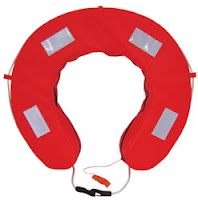I've just remembered the other reason why I didn't sail Maggie between late October and Christmas - I was out for a quick spin to try out my new GPS in about a 10kt SW-W, below is the track - jeez I love the novelty value of this thing!
OK, so it doesn't look like the most exciting sail - but due to the strong current running and the variable wind, our speed relative to land was between 0 and 2kts heading south and between 6 and 8kts heading north. The south bound trip took the best part of 2 hours and the return took 20 minutes!
Before I set sail, I noticed that of the cabin lockers had a little bit of water in it - oh well, so I bailed it out and set off, assuming that the water was just from a leak through the cabin top somewhere. Upon returning I thought I should check to see if any water was in the locker, well we probably had about 5-6 litres. On closer inspection it appeared that we had a leak where one of the keel control rods passes through the hull. OK, looks like I've got a project!
So here's a basic run down on how the swing keel mechanism works. The keel winch handle, located between the outboard gear control arm and the red tool box, is the only bit of the mechanism that you generally need to worry about. What is interesting, is that most of the swing keel Jeddas have the keel winch handle in a different spot!
The handle is connected to a drum (I think - Mental note to self : crawl into that little space and see how it works!!) which is in turn connected to a cable. The cable is then connected to a control rod on each side of the yacht, via various sets of blocks.
The rods (1 per keel) pass through the hull, as shown
The rod is connected to the keel, and raises and lowers the keel as pulled and pushed - I haven't seen the exact configuration of this bit as it is all glassed in and the fewer holes in the boat the better!!
Anyway back to the leak and replacing the gasket...
Step 1: Lower the keels slightly so they rest on the trailer. This will release the tension from the cable.
Step 2: Undo the "D" bolt thing connecting the rod to the block
Step 3: Undo the thumb screw and then remove the big "O" ring thing, remembering to measure where it came from so you can put it back in the same spot!
Step 4: Remove the steel plate and rubber gasket and remember where you put the nuts - I screwed them back on so I wouldn't loose them!
Step 5: Acquiring the gaskets. The gasket is heavy duty rubber about 6mm thick which the local Clark Rubber store had to purchase at minimum meter lengths. The roll was a perfect width for two gaskets, and if I remember correctly I have enough rubber left for another 6 gaskets. The best part was it was only $20!
Step 6: Drilling the holes in the gasket. I used the steel plate as a template for the locating of the holes. The smaller holes were drilled with a standard 6mm (?) drill bit. However, drilling a hole in thick rubber which was going to fit snugly around a 25 mm (maybe 1inch) stainless steel rod took some thought. Initially a machinist who worked with belts and the like was considered, but then once I realised how much excess rubber I had I thought I could experiment. So the winner was making a template out of ply - using a 24mm spade bit on the drill, clamping the rubber between the template and a baking piece of ply and using the spade bit to drill the rubber - worked on absolute treat!!
Step 6: Put the whole lot back together with a bit of Sikaflex between the steel plate and the gasket and the gasket and the hull and Bob's your Uncle no more leak!
So I finally get back down to the boat for the first time after replacing the gaskets and have a look in the cabin locker which had been collecting water and see a nice dry locker...well, actually no -
it's got water in it! Well, fancy that (or words to that effect)!!
Looks like the water is coming from above not below - well...maybe...the side...hmmm... looks like it's time to check the window seals and maybe the hull to cabin connection behind the rubber bumper...
Alternatively, I just go with Plan B - heaps of silicon sealant and a bilge pump!!
Stay tuned....






































cropped.jpg)
